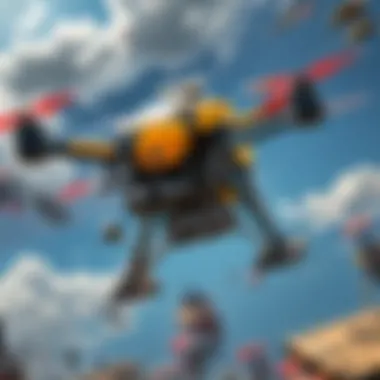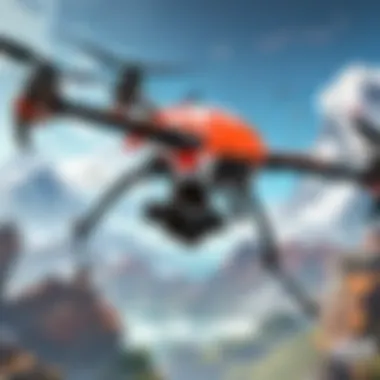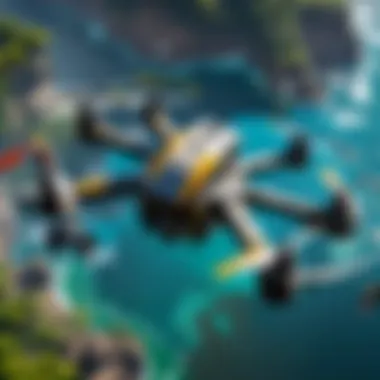Unveiling the Cutting-Edge Innovations in Drone Float Kits for Elevated Aerial Adventures


Game Updates and Patch Notes
The realm of drone float kits has seen a recent surge in advancements aimed at heightening the aerial experience for enthusiasts and professionals. These innovations encompass a wide array of improvements, from enhanced stability to superior maneuverability, fundamentally reshaping the landscape of aerial photography and videography.
Character Guides
As we delve deeper into the realm of drone float kit innovations, it becomes evident that the evolution of these kits plays a pivotal role in enriching the flying experience. Each enhancement, whether it be increased stability or improved maneuverability, serves to redefine the very essence of capturing moments from the sky, offering a fresh perspective to both amateurs and seasoned professionals alike.
Weapon Analysis and Loadout Suggestions
In our exploration of the latest developments in drone float kits, a detailed analysis of the equipment's composition and functionality unveils a world of precision and finesse. By dissecting the intricate details of these kits, enthusiasts can gain insight into the optimal setup for different flying styles and scenarios, ensuring that every flight is not only seamless but also brimming with creative possibilities.
Game Strategies and Tips
Beyond the technical intricacies lies a realm of strategies and tips aimed at optimizing the drone flying experience. By understanding the nuances of aerial dynamics and control, enthusiasts can elevate their skills to new heights, turning each flight into a symphony of movement and precision. Whether it's mastering complex maneuvers or honing one's artistic vision from above, the possibilities are as vast as the open skies themselves.
Introduction
Diving into the realm of drone float kits showcases revolutionary advancements redefining the aerial exploration domain. Unveiling enhanced stability features and maneuverability advancements, these innovations cater to both drone enthusiasts and industry professionals with a penchant for excellence.
Understanding Drone Float Kits
Exploring the essence of drone float kits unveils a realm of technological marvels designed to elevate the aerial experience. The seamless integration of innovative components fosters a new era of flight dynamics, enhancing control, stability, and performance.
Definition of Drone Float Kits
At the core of drone float kits lies a sophisticated assemblage of components aimed at augmenting buoyancy and stability in aerial maneuvers. The meticulous engineering behind these kits ensures optimal balance and control, vital for capturing seamless aerial footage without compromising on safety or efficiency.
Purpose and Benefits
The purpose of drone float kits transcends mere accessory additions to drones; these kits epitomize precision engineering at its finest. By bolstering buoyancy and stability, drone float kits empower enthusiasts and professionals to achieve unparalleled control and maneuverability, essential for capturing stunning aerial visuals with finesse.
Evolution of Drone Float Kits
Tracing the evolution of drone float kits unravels a captivating journey of historical milestones and groundbreaking technological advancements. From rudimentary beginnings to cutting-edge innovations, the trajectory of drone float kits mirrors the relentless pursuit of excellence in aerial exploration.
Historical Overview
The historical evolution of drone float kits epitomizes the gradual refinement of aerial technologies over time. From early rudimentary designs to meticulously engineered structures, each iteration represents a significant leap forward in enhancing the aerial experience.


Technological Advancements
Technological advancements have been pivotal in shaping the modern landscape of drone float kits. Innovations in materials, engineering techniques, and sensor integration have ushered in a new era of precision, reliability, and performance, setting new benchmarks in the realm of aerial exploration.
Significance in Aerial Applications
The significance of drone float kits in various aerial applications underscores their versatile nature and transformative impact on industries ranging from photography to emergency response scenarios.
Aerial Photography
In the realm of aerial photography, drone float kits play a crucial role in enhancing stability, control, and maneuverability, enabling photographers to capture breathtaking visuals from unique vantage points with unparalleled precision.
Agricultural Surveys
For agricultural surveys, drone float kits offer a bird's eye view of vast farmlands, facilitating efficient monitoring, analysis, and decision-making processes. The aerial perspective provided by drones equipped with float kits revolutionizes the agricultural landscape, enabling farmers to make informed choices with unprecedented clarity.
Search and Rescue Operations
In search and rescue operations, drone float kits emerge as indispensable tools for accessing remote or hazardous locations with ease. The agility and resilience offered by these kits empower rescue teams to navigate challenging terrains efficiently, significantly enhancing the effectiveness and safety of search and rescue missions.
Enhanced Stability Features
Exploring the latest innovations in drone float kits involves a crucial focus on enhanced stability features. These features play a pivotal role in improving the overall flight experience of drones. By providing a stable platform for aerial maneuvers, drones equipped with enhanced stability features can capture smoother and more precise footage. The incorporation of advanced stabilization mechanisms, auto-leveling capabilities, and wind-resistance enhancements ensures that drones can withstand external factors and maintain steady flight paths. Enhanced stability features are essential for both enthusiasts and professionals engaged in aerial photography, videography, agricultural surveys, and search and rescue operations. Not only do these features enhance flight performance, but they also contribute to the safety and efficiency of drone operations, making them indispensable components of modern drone float kits.
Improved Gyroscopic Systems
Improved gyroscopic systems are a fundamental aspect of enhancing stability in drone float kits. The stabilization mechanisms within gyroscopic systems serve to counterbalance any external forces acting on the drone, thereby maintaining a steady and level flight attitude. The gyroscopic systems' impact on flight performance is significant, as they ensure precise control and responsiveness during maneuvers. One of the key characteristics of stabilization mechanisms is their ability to swiftly adapt to changing flight conditions, ensuring optimal stability in various environments. While the unique feature of these systems lies in their ability to mitigate turbulence and maintain a steady hover, they may also add weight to the drone, affecting its overall agility and speed.
The impact of improved gyroscopic systems on flight performance is multifaceted. By providing enhanced stability and precise control, these systems enable drones to execute complex maneuvers with ease. This aspect is particularly beneficial for aerial photographers and videographers, as it allows for the capture of smooth and professional-looking footage. However, the added weight of gyroscopic systems can potentially impact the drone's battery life and flight duration. Despite this limitation, the advantages of increased stability and flight control outweigh the drawbacks, making improved gyroscopic systems a popular choice for drone enthusiasts and professionals alike.
Auto-Leveling Capabilities
Auto-leveling capabilities are integral to ensuring stable and controlled flight in drone operations. Enhanced control is a key characteristic of auto-leveling capabilities, allowing pilots to maintain a consistent and level flight path without manual input. This feature is especially beneficial for novice drone operators, as it reduces the complexity of flying and minimizes the risk of accidents due to pilot errors. The unique feature of auto-leveling capabilities lies in their ability to automatically adjust the drone's orientation to counteract any external disturbances, such as gusts of wind or uneven terrain.
Mitigating external factors is another crucial aspect of auto-leveling capabilities. By actively compensating for environmental conditions that could destabilize the drone, these systems enhance flight safety and ensure smooth aerial operations. While the benefits of auto-leveling capabilities are evident in maintaining steady flight paths and improving overall control, they may limit the pilot's ability to execute advanced maneuvers that require manual intervention. Despite this trade-off, the advantages of enhanced control and safety make auto-leveling capabilities a preferred choice for drone operators seeking stability and ease of flight.
Wind-Resistance Enhancements
Tackling wind challenges is a vital component of drone float kits equipped with wind-resistance enhancements. The ability to withstand gusts of wind and maintain stability is crucial for ensuring smooth and controlled flight in adverse weather conditions. By integrating features that enhance wind resistance, drones can navigate challenging environments with greater ease and precision. The key characteristic of tackling wind challenges is the drone's ability to remain stable and steady even in turbulent air currents, enabling reliable performance during aerial operations.


One of the significant advantages of wind-resistance enhancements is the increased flight duration they offer. By optimizing the drone's aerodynamics and structural design to minimize the impact of wind resistance, operators can significantly extend the drone's airborne time. This extended flight duration is particularly beneficial for tasks that require prolonged aerial surveillance or photography. However, the trade-off for increased wind resistance may involve added weight or drag, potentially affecting the drone's overall speed and agility. Despite this consideration, the benefits of prolonged flight time and improved stability make wind-resistance enhancements a valuable addition to drone float kits seeking enhanced performance in challenging weather conditions.
Maneuverability Advancements
In the realm of drone technology, Maneuverability Advancements play a pivotal role in shaping the flying experience. The ability of drones to maneuver swiftly and accurately is crucial for various applications, ranging from recreational aerial stunts to precision-based tasks. By enhancing maneuverability, drone operators can execute intricate flight maneuvers with ease, resulting in improved performance and expanded creative possibilities. Factors such as agility, responsiveness, and stability are key considerations when evaluating the maneuverability of a drone. The evolution of Maneuverability Advancements has introduced sophisticated control systems and enhanced flight modes, empowering users to navigate drones with precision and finesse.
Enhanced Flight Modes
Acrobatic Maneuvers
Acrobatic Maneuvers epitomize the pinnacle of aerial dexterity and skill, allowing drone pilots to perform an array of gravity-defying tricks and stunts. These maneuvers demand exceptional coordination and control, pushing the boundaries of what drones can achieve in terms of aerobatics. The key characteristic of Acrobatic Maneuvers lies in their dynamic and flamboyant nature, captivating audiences with their visual splendor. While Acrobatic Maneuvers add a thrilling dimension to drone flying, they require a high level of proficiency and caution due to the inherent risks involved. As one of the featured elements in this article, Acrobatic Maneuvers showcase the daring possibilities unlocked by advanced drone technology.
Precision Flying
Precision Flying represents the epitome of control and accuracy in drone operation, enabling pilots to execute precise movements and maintain stable flight paths. The hallmark of Precision Flying is its ability to achieve pinpoint navigation and exact positioning, essential for tasks that demand meticulous attention to detail. This flight mode emphasizes smooth, controlled motion, making it a preferred choice for scenarios requiring finesse and exactitude. While Precision Flying enhances the user's ability to achieve specific objectives with ease, its reliance on intricate flight controls necessitates a nuanced approach to ensure optimal performance. As a valuable component of this article, Precision Flying exemplifies the pursuit of excellence in drone maneuverability.
Remote Control Range Extension
Increased Coverage
One of the key advantages of Expanded Coverage is the extended reach it provides for drone operations. By increasing the operational radius of the drone, this feature opens up new possibilities for exploration and data collection. Enhanced coverage enables users to venture into distant or inaccessible areas, capturing footage and information from unique vantage points. The primary characteristic of Increased Coverage lies in its ability to transcend traditional constraints, offering greater flexibility and scope for drone enthusiasts and professionals alike. While this feature enhances the user's spatial freedom, it also necessitates a cautious approach to ensure responsible and effective utilization. Integrated as a vital aspect of this article, Increased Coverage highlights the advancements in remote control technology shaping modern drone capabilities.
Communication Stability
Communication Stability underpins the reliability and continuity of interactions between the drone and its controller, ensuring seamless data transmission and command execution. The critical attribute of Communication Stability is its capacity to maintain a robust connection under varying environmental conditions, preventing signal loss or interference. This feature enhances user confidence and operational efficiency, enabling uninterrupted communication and control throughout the drone's flight duration. While Communication Stability reinforces the pilot's command over the drone, vigilance and adherence to best practices are essential to optimize performance and reliability. Embedded within this article, Communication Stability underscores the significance of secure and uninterrupted communication in the domain of drone technology.
Obstacle Avoidance Systems
Detecting and Evading Obstacles
Detecting and Evading Obstacles represent a crucial capability that safeguards the drone against collisions and potential hazards during flight. By employing advanced sensors and algorithms, drones can identify obstacles in their path and autonomously adjust their trajectory to avoid accidents. The primary feature of Detecting and Evading Obstacles is their real-time threat assessment and swift response mechanism, mitigating risks and ensuring safe operation in dynamic environments. This system bolsters overall flight safety and minimizes the likelihood of accidents or damage caused by unforeseen obstacles. While Detecting and Evading Obstacles enhance the drone's navigational intelligence, user vigilance and system calibration are imperative to maximize efficacy and prevent incidents. Positioned within this article, Detecting and Evading Obstacles highlight the proactive measures adopted to enhance drone safety and operational reliability.
Safety Measures
Safety Measures encompass a range of features and protocols designed to promote responsible and secure drone operation, prioritizing user and environmental safety. These measures include fail-safe mechanisms, emergency landing procedures, and collision avoidance systems that uphold operational integrity and protect against potential risks. The central tenet of Safety Measures is to mitigate accidents, ensure regulatory compliance, and safeguard the well-being of operators and bystanders. While safety precautions enhance overall operational security, user adherence to protocols and regular maintenance are essential for sustainable and safe drone usage. Integrated within this article, Safety Measures underscore the industry's commitment to fostering a culture of safety and accountability in drone technology.
Innovative Materials and Designs
In the realm of drone technology, the significance of innovative materials and designs cannot be understated. These elements play a pivotal role in enhancing the overall performance and functionality of drones, particularly in the context of float kits. By incorporating cutting-edge materials and streamlined designs, drone enthusiasts and professionals can experience a new level of efficiency and reliability in their aerial endeavors.


Carbon Fiber Composites
Lightweight Construction
Within drone engineering, lightweight construction using carbon fiber composites stands out as a hallmark of innovation. The key characteristic of this construction method lies in its exceptional strength-to-weight ratio, providing drones with a sturdy yet lightweight frame. This choice is particularly advantageous for drone float kits as it enables extended flight times without compromising structural integrity. Moreover, the unique feature of carbon fiber composites lies in their ability to withstand harsh environmental conditions, showcasing unparalleled durability in varied settings.
Durability Factors
When discussing durability factors in the context of drone float kits, the robust nature of carbon fiber composites emerges as a game-changer. The inherent resilience of these composites enhances the longevity of drones, making them ideal for prolonged and demanding aerial missions. The key characteristic here is the material's resistance to impact and stress, ensuring that drones remain operational even in challenging circumstances. While the advantage of durability is evident, a consideration to note is the higher cost associated with carbon fiber composites, which is justified by their exceptional performance and longevity.
Streamlined Hydrodynamic Shapes
Reducing Air Resistance
Streamlined hydrodynamic shapes play a crucial role in minimizing air resistance during flight, optimizing the aerodynamic efficiency of drones equipped with float kits. The key characteristic of these shapes lies in their ability to minimize drag, allowing drones to move swiftly and steadily through the air. This choice is popular among drone enthusiasts and professionals for its capacity to enhance overall flight stability and control. The unique feature of streamlined hydrodynamic shapes is their contribution to reducing energy consumption during flight, ultimately prolonging battery life and ensuring extended operating times.
Enhancing Speed
Enhancing speed through streamlined hydrodynamic shapes offers significant advantages for users seeking dynamic and swift drone performances. The key characteristic in this enhancement is the improved acceleration and agility achieved by reducing drag and optimizing airflow around the drone. This choice is beneficial as it caters to scenarios requiring fast maneuvering and rapid responses. However, a notable consideration is that increased speed may impact the drone's maneuverability at lower velocities, necessitating skillful piloting to maximize its benefits.
Modular Component Systems
Customization Options
Modular component systems provide users with diverse customization options for tailoring their drone setups to specific needs and preferences. The key characteristic of this approach is flexibility, allowing enthusiasts to modify drone functionalities according to varying requirements. This choice is popular among drone enthusiasts who seek versatility and adaptability in their equipment, enabling them to explore different aerial tasks effectively. The unique feature of modular component systems is their interchangeability, which fosters ease of upgrading or repairing drone components without extensive technical knowledge or tools.
Interchangeable Parts
The option of interchangeable parts within modular component systems offers a practical solution for drone users looking to streamline maintenance and enhance versatility. The key characteristic here is the ease of swapping out components without complex procedures, facilitating quick adjustments or repairs as needed. This choice is beneficial for users engaging in field operations where rapid changes or replacements are essential. However, a consideration to bear in mind is ensuring compatibility between interchangeable parts to avoid operational disruptions or performance inconsistencies.
Future Prospects and Industry Impact
In the realm of drone technology, the future prospects and industry impact hold immense significance. The integration of AI (Artificial Intelligence) and Io T (Internet of Things) introduces a new era of capabilities and possibilities. By harnessing smart drone capabilities, operators can access advanced functionalities that streamline and enhance the overall drone flying experience. These smart drone capabilities offer a sophisticated level of automation and intelligence, revolutionizing how drones operate and interact with their environments.
Smart drone capabilities empower operators by providing automated flight modes, intelligent obstacle detection and avoidance systems, and precise navigation features. These aspects not only improve efficiency but also bolster safety during drone operations. The integration of AI and Io T in drone technology brings about a host of benefits, including improved decision-making algorithms, real-time data processing, and adaptive systems that can optimize flight parameters based on environmental conditions.
Furthermore, the data analytics integration in drones facilitates comprehensive data collection and analysis during flights. This integration allows for the extraction of valuable insights from the gathered data, enabling operators to make informed decisions and enhance their overall drone operations. By leveraging data analytics, drone users can monitor performance metrics, track flight patterns, and identify areas for operational refinement.
The market trends and demand in the drone industry play a pivotal role in shaping the direction of future drone innovations. Understanding consumer preferences is crucial for manufacturers and developers to align their product offerings with market demands. Consumer preferences encompass factors such as flight performance, camera capabilities, ease of use, and overall drone functionality. By adapting to evolving consumer preferences, drone companies can stay ahead of the competition and cater to the specific needs of their target audience.
Moreover, the commercial applications of drones continue to expand across various industries, including agriculture, construction, and cinematography. Drones are increasingly being utilized for tasks such as aerial surveying, monitoring crop health, and conducting aerial inspections. The deployment of drones in commercial settings not only improves operational efficiency but also reduces costs and enhances safety protocols.
However, the drone industry also faces regulatory challenges and compliance requirements related to airspace regulations and safety standards. Adhering to airspace regulations is crucial to ensure safe and responsible drone operations. By complying with established airspace guidelines, drone operators can mitigate risks related to airspace congestion, collision avoidance, and unauthorized flights. Similarly, upholding safety standards is essential to safeguarding individuals, property, and the integrity of drone operations. Implementing robust safety protocols and adhering to industry standards are instrumental in fostering a secure and sustainable drone ecosystem.
T, the evolving market trends, and the adherence to regulatory standards collectively shape the trajectory of the drone industry. By leveraging smart drone capabilities, harnessing data analytics, adapting to consumer preferences, exploring new commercial applications, and upholding regulatory compliance, the drone sector can continue to thrive and innovate, paving the way for a dynamic and progressive future.



